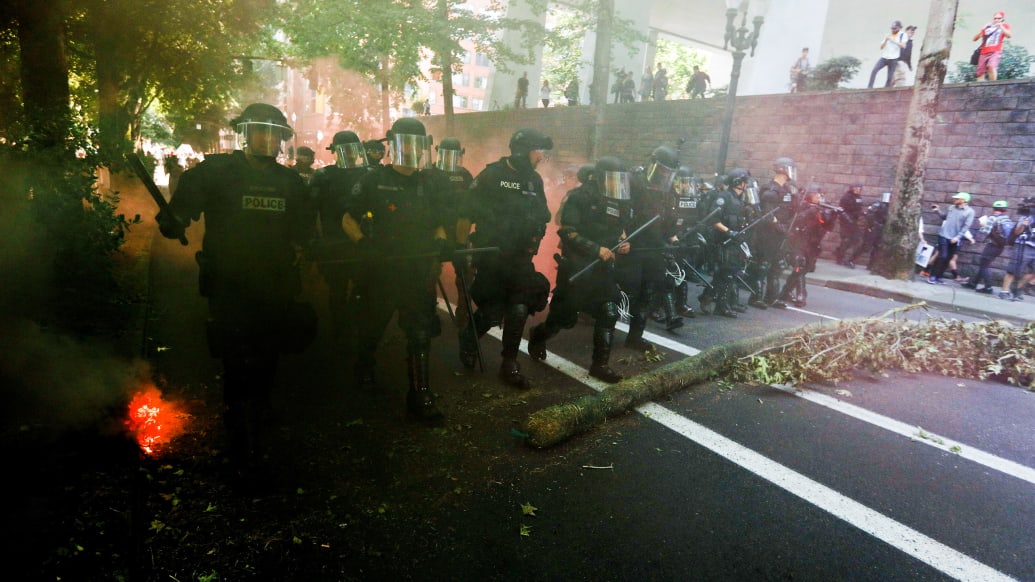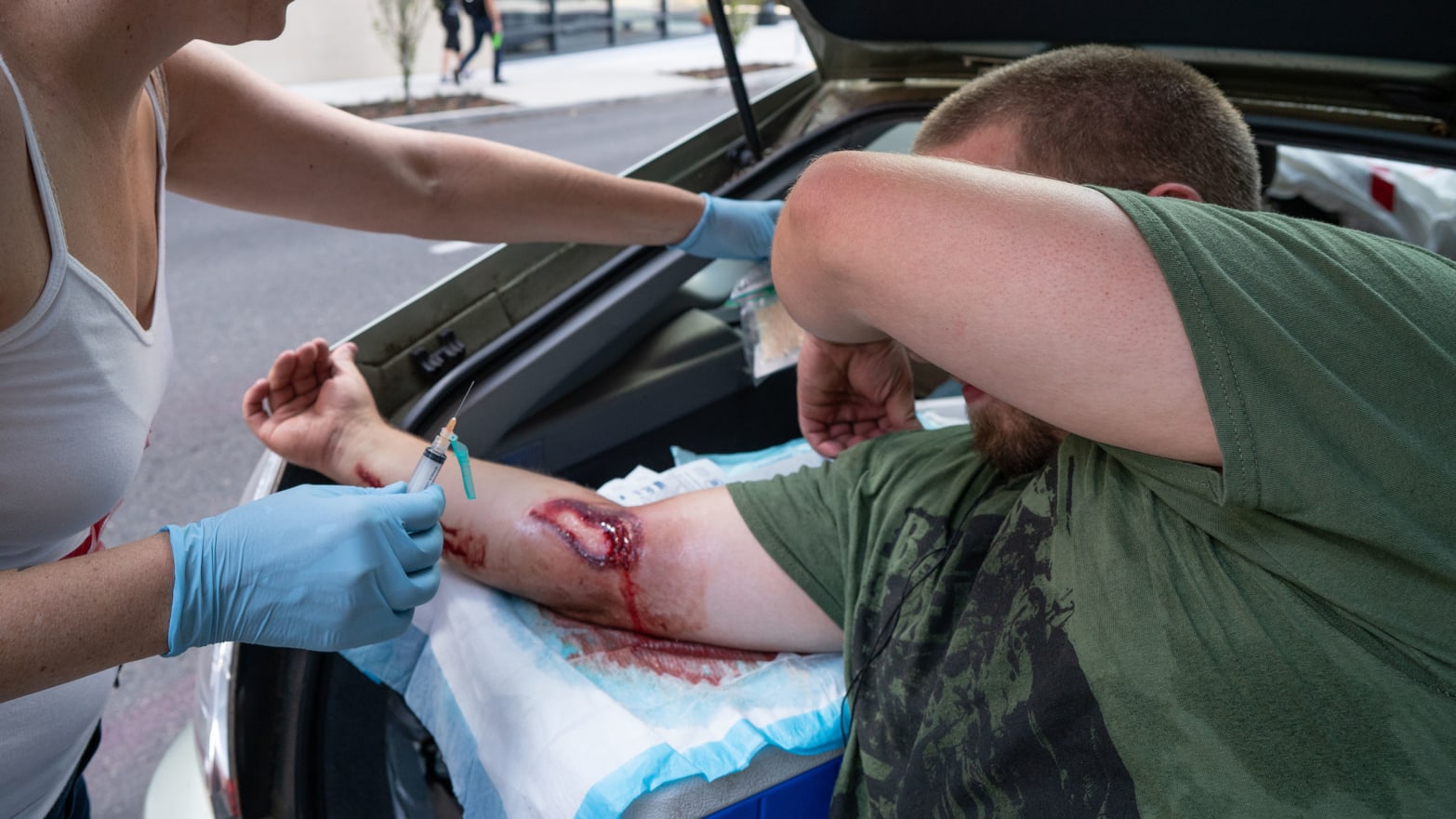PORTLAND, Oregon—Days later there’s still a bloodstain on the sidewalk where a police stun grenade smashed into Anthony’s head.
Anthony, who asked to be identified only by his first name, was injured last weekend when cops in riot gear unleashed flashbangs, pepper spray, rubber bullets and other less-lethal weapons as local protesters demonstrated against far-right groups massed downtown.
In his first interview, he told The Daily Beast he was running from what many observers have described as an unprovoked police assault when the grenade punched through an air hole in the bicycle helmet he was wearing for protection.
“It was ‘pow’—a big noise,” he said. “Everything turned red, and I could hear my breathing. It was like a video game when you’re dying.”
“My hand and arm were covered in blood,” he said. “My shirt was soaked in blood. I saw all the blood on the ground. It was the fresh dark, dark blood. I didn’t know if part of my brain was hanging out. I asked the medic if I was going to bleed out. I thought I was going to die.”

Mark Graves/Oregoinian via AP
Anthony was one of at least five people who sought emergency medical care after the Aug. 4 police onslaught—a group that includes this reporter’s partner, who ended up with third-degree burns. Anthony was diagnosed with a minor brain hemorrhage, and a 29-year-old man had his arm ripped apart.
All of them say the city was turned into a war zone by a police force seeking to protect hundreds of outside extremists—Proud Boys, neo-Nazis and neo-Confederates among them—who came dressed for combat.
Portland police contend that they only used the grenades and pepper-spray to disperse a crowd of counter-protesters after objects were thrown at officers. But reporters covering the face-off—including those from the local Oregonian, The Guardian, and Willamette Week—say projectiles were thrown only after the police attacked the demonstration without provocation, and unedited footage and interviews with nearly 20 protesters near the front lines appears to support that.
Portland Police Chief Danielle Outlaw has denied that police were trying to protect the far-right demonstrators by moving on the counter-protesters but she has ordered a review of the use of force.
After he was hit, Anthony recalls, he stumbled forward in fear of the police behind him. “I was waving my arms. I was trying to yell for help, but no sound was coming out,” he said.
As he slumped down at a bus stop shelter, he drew attention from onlookers and street medics who volunteer at demonstrations.
“People gasped, ‘Oh my God!’ and ‘Holy shit!’ at the mess my head was,” Anthony remembered. He said that even as medics bandaged him, they were in danger.
“It was like a fucking battle zone: I could hear explosions… I could hear pepper balls. I could hear people yelling and screaming.”
He said he had to be moved twice as rows of riot cops advanced, using six types of riot-control and less-lethal weapons and devices, including rubber and foam bullets. Medics stashed him near a wall until an ambulance arrived. One medic cradled his head the entire ride to hold it still while another took his pulse and administered an eye test to check for neurological damage. By the time he was admitted to a hospital, nearly an hour had passed.
Assistant Police Chief Ryan Lee has tried to cast doubt on what happened to Anthony, implying the flash bang grenade could not puncture a helmet and questioning if pictures of the helmet on social media were “indeed an accurate image.”
Anthony allowed The Daily Beast to examine the helmet and provided his medical record and a photo of the blood on the sidewalk. The dimensions of the canister that lodged in the helmet are consistent with specifications of the police weapon, and the wound and his head match those in pictures that circulated shortly after he was injured. There was blood on the foam inside the helmet in the shape of the wound on his head.
A trauma nurse at the hospital said the hit “would have been lethal if he wasn’t wearing a helmet,” according to Anthony’s partner.
This reporter’s partner was standing only a few yards away from Anthony and said she believes she was hit by the first flash-bang grenade.
“Suddenly I heard a deafening explosion and was hit by a powerful impact on my chest and arm. I looked down and saw the skin had been burned off my left arm,” said Fawcett, a Portland resident and former NYU adjunct professor.
“I didn’t know what happened to me. I didn’t know what hit me. I didn’t know where to get help. I was clutching my chest, which was in burning pain. I thought I was going to have a heart attack.”
The grenades, which Portland Police described as an “aerial distraction device,” produce an ear-shattering sound and shock of light and also contain three chemical agents.
A ProPublica investigation found that “at least 50 Americans... have been seriously injured, maimed or killed by flashbangs since 2000.” It adds “that is likely a fraction of the total since there are few records kept on flashbang deployment.”
Portland police have been criticized for indiscriminate use of less-lethal ammunition. The Oregon ACLU says that to its knowledge, “no other police force in America uses crowd control weapons with the regularity of the Portland Police Bureau.”
James Mattox, who works as a truck driver, said he was hit by rubber bullets and then treated like he was in a real war zone, with a surgeon stitching him in a car that served as a kind of field hospital.
Mattox, who was near Anthony and Fawcett when stun grenades began exploding, has been a regular at Portland protests for a few years and admits to taunting police.
“I verbally provoke the crap out of them. But that doesn’t mean you have a right to shoot me,” he said.
Mattox said he was four blocks away from the initial police assault when a rubber bullet hit his thigh “one inch away from my testicles.” He said he grabbed the round with his right hand, held it up, and yelled at cops hundreds of feet away, “Fuck you. You missed! Is that the best you got?”

Bob Strong/Reuters
With his arm outstretched, a second rubber bullet smashed into it, he said.
“They got me with a good amount of force. There was a gash in my arm. It looked like chicken fat. It was bleeding right away, a steady drip,” he said.
In shock, Mattox started running and yelling, “Medic!”
Andrea Chiavarini, a Portland-based obstetrician and supporter of anti-fascist protests who was working as a medic at the protests, heard his cries. She led him back to her Prius, opened the hatchback, and affixed surgical drapes to a cooler to fashion an operating station.
Mattox told her that he preferred to be patched up on the spot because he was wary of going to a hospital where police might detain him. (It turned out police personnel did visit hospitals searching for anyone injured).
Chiavarini cleaned and lightly numbed Mattox’s gaping wound. “Then I gave him a shot of lidocaine, and irrigated it with saline and betadine, a surgical prep solution,” she said. “I put some dissolvable stitches underneath the skin to bring the tissue together. I put removable stitches to close it up, bandaged it, and gave him post-op instructions.”
Anthony says the experience of being shot has left him even less trusting of police.
“The police are supposedly here to protect you and they shoot you in the back of the head running away. But it doesn’t surprise me. We’ve all seen the video of police shooting a Black person in the back. They are ultimately responsible for people’s lives. What do you think would have happened if they killed me? There would be no ramifications. That cop would be on paid administrative leave and Chief Outlaw would be defending the use of force.”
